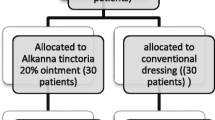Abstract
Skin is the most commonly used tissue for the transplantation. A meticulous care of the donor site is needed to prevent scarring, delayed healing, and pain. Various agents and dressing materials have been reported to help healing of skin graft donor sites. Sucralfate is an extensively used agent, which provides acute gastroprotection and acceleration of chronic ulcer healing. In this study, we assessed the effects of topical sucralfate on the healing of the split thickness skin graft donor sites in a prospective comparative way. The study was carried out on 32 randomly chosen patients undergoing surgery for various causes and requiring split thickness skin graft resurfacing. The upper halves of the skin graft donor sites on the thighs were simply covered with paraffin gauze and the lower half was covered with sucralfate-soaked paraffin gauzes. The day of full epithelization varied from 6 to 9 days and 8–12 days on the sucralfate-applied areas and on the control sites, respectively. The mean value of the healing was 7.01 days in the studied lower halves and 10.8 days in the upper halves. The healing rate was strikingly faster and less painful on the sucralfate-applied areas. We were able to discharge patients earlier than usual, and patients’ comfort increased. It seems that sucralfate is a promising topical agent to increase the healing rate and decrease the incidence of associated problems such as pain and hypertrophic scar.


Similar content being viewed by others
References
Akan M (2003) Ice application to minimize pain in the split thickness skin graft donor site. Aesthet Plast Surg 27:305–307
Atwood Al (1989) Calcium alginate dressing accelerates split skin graft donor site healing. Br J Plast Surg 42:373–379
Barnea Y, Amir A, Leshem D, Zaretski A, Weiss J, Shafir R, Gur E (2004) Clinical comparative study of aquacel and paraffin gauze dressing for split-skin donor site treatment. Ann Plast Surg 53:132–136
Cadier MA (1996) Dermasorb versus Jelonet in patients with burns skin graft donor sites. J Burn Care Rehabil 17:246–251
Chuenkongkaew T (2003) Modification of split-thickness skin graft: cosmetic donor site and better recipient site. Ann Plast Surg 50(2):212–214
Converse JM (1944) The healing of surface cutaneous wounds: its analogy with the healing of superficial wounds. Ann Surg 120:873
Disa JJ, Alizadeh K, Smith JW, Hu Q, Cordeiro PG (2001) Evaluation of a combined calcium sodium alginate and bio-occlusive membrane dressing in the management of split-thickness skin graft donor sites. Ann Plast Surg 46:405–408
Folkman J, Klagsburn M (1987) Angiogenic factors. Science 235:442–447
Glise H, Carling L, Hallerbeck B, Kagevi I, Solhaug JH, Svedberg LE, Wahlby L (1987) Treatment of peptic ulcers—acid reduction or cytoprotection. Scand J Gastroenterol 22:39–47
Hallock G (1999) The cosmetic split thickness skin graft donor site. Plast Reconstr Surg 104(7):2286–2288
Hollander D (1987) Sucralfate protection of the gastric mucosa mediated by endogenous prostaglandins. In: Szabo S, Mozsik G (eds) New pharmacology of ulcer disease: experimental and new therapeutic approaches. Elsevier, NewYork, pp 404–412
Innes ME (2001) The use of silver coated dressings on donor site wounds: a prospective, controlled matched pair study. Burns 27:621–627
Jones PH (1995) Stem cell patterning and fate in human epidermis. Cell 80:83
Kiline H (2001) Which dressing for split thickness graft donor sites? Ann Plast Surg 46(4):409–414
Lacey ER (1984) Rapid epithelial restitution in the rat gastric mucosa after ethanol injury. Lab Invest 51:573–583
Losada F (2002) Effects of human recombinant growth hormone on donor site healing in burned adults. World J Surg 26:2–8
Malpass KG (2003) Comparison of donor site healing under Xeroform and Jelonet dressings: unexpected findings. Plast Reconstr Surg 112(2):430–439
Misirlioglu A (2003) Use of honey as an adjunct in the healing of split thickness skin graft donor site. Dermatol Surg 29:2
Ozcan M, Altuntas A, Unal A, Nalca Y, Aslan A (1998) Sucralfate for posttonsillectomy anesthesia. Otolaryngol Head Neck Surg 119(6):700–704
Sawhney CP (1969) Healing of donor sites of split skin grafts: an experimental study in pigs. Br J Plast Surg 22:359
Stone CA (2000) Healing at skin graft donor sites dressed with chitosan. Br J Plast Surg 53:601–606
Szabo S (1991) The mode of action of sucralfate: the 1 × 1 × 1 mechanism of action. Scand J Gastroenterol 26(suppl. l85):7–12
Tytgat GNJ (1990) Future potential applicability of sucralfate in gastroenterology. Scand J Gastroenterol 25:34–38
Yamamoto E (1987) Effects of sucralfate on healing of chronic gastric ulcers in rats. In: Szabo S, Mozsik G. (eds) New pharmacology of ulcer disease: experimental and new therapeutic approaches. Elsevier, NewYork, pp 413–423
Author information
Authors and Affiliations
Corresponding author
Rights and permissions
About this article
Cite this article
Civelek, B., Inal, H.İ., Ozdil, K. et al. The effect of sucralfate, an agent for gastroprotection on the healing of split thickness skin graft donor sites. Eur J Plast Surg 30, 25–28 (2007). https://doi.org/10.1007/s00238-007-0140-z
Received:
Accepted:
Published:
Issue Date:
DOI: https://doi.org/10.1007/s00238-007-0140-z




